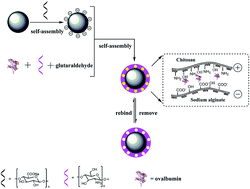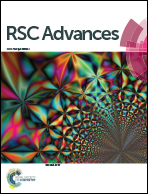Facile and green synthesis of polysaccharide-based magnetic molecularly imprinted nanoparticles for protein recognition†
Abstract
In this study, a facile and green approach to prepare core–shell magnetic molecularly imprinted nanoparticles based on a layer-by-layer assembly and surface imprinting technique was developed. Two types of natural polysaccharides (sodium alginate and chitosan) were firstly employed as hydrophilic double-monomers to synthesize water-compatible imprinted nanomaterials via a two-step self-assembly strategy for recognizing protein ovalbumin. The obtained products exhibited a desired level of magnetic susceptibility (45.30 emu g−1), resulting in the convenient and highly efficient separation process. The imprinted layer with thickness about 8 nm was homogeneously coated on the surface of Fe3O4, which was favorable for the fast mass transfer and rapid binding kinetics. The results of adsorption experiments showed that the saturation adsorption capacity of imprinted products could reach 92.22 mg g−1 within 40 min, which illustrated the high binding capacity. Meanwhile, the imprinting factor was as high as 4.07, demonstrating the potential selectivity of the prepared products. More importantly, the test of validation suggested that the proposed strategy would be a general method for imprinting different proteins in aqueous media by virtue of the peculiarity of polysaccharides as well as the efficient preparation process.


 Please wait while we load your content...
Please wait while we load your content...